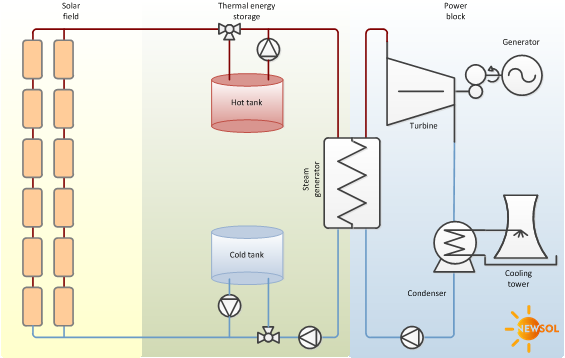The increasing share of renewable energy in the energy mix tends naturally to decrease the share of conventional energy sources. However, due to the reduced possibility of storing electricity, variable renewables (e.g. wind power and photovoltaics) are only available when the resource is available, lacking dispatchability and thus decreasing the flexibility of the power grid.
Hence, more dispatchable energy sources are needed and Concentrating Solar Power (CSP) presents that benefit, using Thermal Energy Storage (TES).
TES includes several different technologies and temperature ranges. Nonetheless, energy can be stored as sensible heat, latent heat or even as chemical energy (i.e. thermo-chemical energy storage). Sensible heat thermal storage is achieved by heating the storage medium (e.g. liquid sodium, molten salt or pressurized water) and increasing its energy content but not changing state. Energy is released and absorbed by the medium as its temperature reduces and increases respectively. Sensible heat can be stored in either solid media (e.g., in packed beds or concrete, requiring a fluid to exchange heat) or in liquid media such as molten salt or pressurized water.
On the other hand, latent heat is associated with changes of phase. Energy required during charging is used to convert a solid material in a liquid material (such as paraffin wax), or a liquid material into a gas. Phase change materials have the benefit of high thermal capacity but have the drawback of degrading performance after a number of freeze-melt cycles. In order to use latent heat storage, the storage material should have a melting temperature within the range of the desired operation temperatures of the Heat Transfer Fluid (HTF). Similarly, endothermic chemical reactions require a specific temperature at which a chemical product is dissociated in a reversible chemical reaction and heat is retrieved when the synthesis reaction takes place. The development of such reactions is yet at a very early stage, the reaction temperature should lie within the charging and discharging temperature of the HTF, therefore the use of such technology needs to be case specific.
Since the first test of a large-scale thermal solar power tower plant – the Solar One project that was operational from 1982 to 1986 in the Mojave Desert, just east of Barstow, CA, USA – several sensible thermal energy storage technologies have been tested and implemented. These include the two-tank indirect system (Figure 1), two-tank direct system (Figure 2), and single-tank thermocline system (Figure 3). One of the benefits of the direct system over the indirect system is the savings in cost and in complexity of the system by not having the heat exchanger between the solar field and an exclusive storage fluid. The advantage of the thermocline system over the two tank systems is the savings in the number of tanks used, the savings in the heat exchanger and the savings of replacing part of storage fluid by a high specific heat and cheap material such as rock. The amount of replaced fluid can be over 70%, depending on the packed porosity of the solid material.



The NewSOL project will develop two sensible heat storage systems based both on a single-tank with thermocline and solid state heat storage in concrete and aimed to a temperature range from 290 ºC up to 550 ºC. The main difference from the several existing proposals is to implement a single-tank system constructed in concrete instead of the classic metallic construction. The main goals are to test the materials with real load and to develop control schemes in order to improve the performance of the storage, thus preventing thermocline degradation due to cycling.